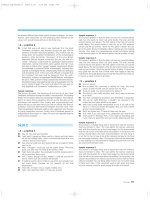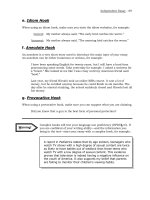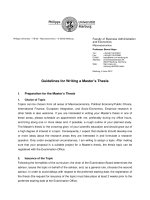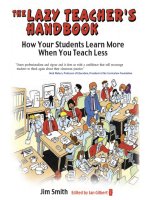Praise for The Lazy Teacher’s Handbook pptx
Bạn đang xem bản rút gọn của tài liệu. Xem và tải ngay bản đầy đủ của tài liệu tại đây (3.56 MB, 218 trang )
Praise for The Lazy Teacher’s Handbook
If being lazy could be seen as an accolade, then the author of this
book would deserve one. Jim Smith has brought laziness to a new
level. The book explains how teachers can enjoy their
responsibility by helping the learners to realise that they have to
share the work…and in doing so they will enjoy it and find it
fulfilling.
Of course, ‘lazy’ is a misnomer; the book oozes professionalism
and rigour and it does so with a confidence that will encourage
teachers to think again about their classroom practice. It is about
the highest quality learning brought about by taking a different
slant on how the teacher needs to perform. It is full of the
practical explanations of how to make things work and sensible
explanations to support classroom organisation. Over the years
we have enjoyed seeing cooks, gardeners and DIY experts let us
into their trade secrets. This book does it for teachers.
Mick Waters, Professor of Education,
President of the Curriculum Foundation
There are many books on the market which offer a compendium
of fun and funky ideas for teachers anxious to engage their
students more actively in their classes. However I’ve not
encountered many to match this one for writing style (lucid, easy
and entertaining, much in the manner of his mentor Ian Gilbert),
organisation and coherence to a unifying idea – the notion that
teachers can and should teach less so that learners learn more.
In offering up his ‘Lazy Way’ antidote to teacher fatigue and
student passivity I’m reminded of John West-Burnham’s suspicion
that children go to school in order to watch their teachers work.
The author of this book sets about combating these tendencies
2
with a series of chapters addressing such themes as lesson
outcomes, marking, IT, classroom language, differentiation, SEAL
(Social and Emotional Aspects of Learning), the use of teaching
assistants, etc, and packing each with a pot-pourri of ideas for
practical and learner-led classroom activities. Few of these
activities are original, although many have been given creative
twists. On the contrary, in keeping with the ‘Lazy Way,’ the
author has unashamedly pinched and synthesised ideas from a
rich panoply of sources – his past and present colleagues, courses
he’s attended, books he’s read (Sue Cowley’s oeuvre is an
apparent influence) and – perhaps most significantly and
congruently – students he’s taught. The overall product is a
delight and will be richly welcomed by teachers seeking to claim
back their lives in the face of relentless demands imposed by
national diktat, institutional expectations, student and parental
expectations, and their own inner voices of guilt and self-denial.
Although this book orients itself deliberately towards the
hardpressed classroom practitioner and therefore wears its
research base lightly, there is very little within it that doesn’t
have a distinguished academic pedigree as a buttress – not least
a strong emphasis on reflective, metacognitive and meta-learning
tasks which put the learner in control of his or her own learning
development. It will therefore avoid the charge justly levelled at
some of its antecedents – that it’s not much more than a populist
collection of superficially attractive but learning- and evidence-lite
tips-for-teachers of the ‘Here’s another learning style
questionnaire’ variety.
In summary, this book deserves a place in every staffroom. Place
it on the centre table, invite all staff to enjoy it and then, to
misquote Auden,
Stop all the bells, disconnect the LCD
3
Deny the kids a wordsearch with a mental age of three
Dazzle the inspector and with seated bum
Bring on Independence, and let Learning come.
Dr Barry Hymer, Managing Director,
Still Thinking UK Ltd and Visiting Fellow,
Newcastle University’s Centre for Learning and Teaching
Jim Smith has produced a lively, humorous and invaluable guide
to teaching in ‘The Lazy Teacher’s Handbook’. He makes the
crucial point that he makes for teachers like me is that you can be
a more effective teacher by doing less: less photocopying, less
indepth planning, less fussing about discipline. If you imbibe the
essential principles he outlines in the book, you’ll find yourself
with a great toolkit of pupil-proof teaching techniques which will
make you enjoy your teaching more and help you get better
results. I learnt a lot from the book and would whole-heartedly
recommend it to other colleagues.
Francis Gilbert, author I’m A Teacher, Get Me Out Of Here
and Working The System: How To Get The Best State
Education For Your Child, www.francisgilbert.co.uk
This is an ideal book for those students and teachers willing to
think creatively – outside the box. As an adviser, inspector and a
trainee mentor it is always a privilege to observe inspirational
teaching – the best of which appears effortless – not so of course.
I recall one lesson in particular, a KS2 geography lesson with a
mixed age group. I was a few minutes late and missed the
remarkably short introduction. The young, petite, soft spoken
teacher was almost invisible in the class but the pupils were
working so hard, enthused by the tasks, thinking and learning
4
collaboratively. This was no ‘lazy teacher’ - the activities had
been researched and prepared thoroughly. The role of the
teacher should be that of a facilitator – and that is the underlying
message of this book –‘what if we worked less and they worked
more’ / ‘the combination of independent learners and lazy
teachers is the outstanding combination that every school should
be striving for’.
It is a catalogue of good practice – with emphasis on reflection by
the practitioner, minimizing the use of the dreaded worksheets,
offering a range of strategies promoting collaborative learning in
tune with the individualized, personalized and independent
learning agenda and effective classroom management, the
effective use of classroom assistants and IT. The strategies are
not all new and reference is made to several other publications
such as Ian Gilbert’s Little Book of Thunks and Blooms’ Taxonomy
but the catalogue is well set out and is very readable, the most
useful being the many strategies offered to improve group work
and discussion. It is an effective summary of good practice.
The most progressive sections are the chapters which deal with
outcome-led learning and planning. Tips such as - ‘don’t just wait
for the end of the lesson to reflect on outcomes’, revisiting the
learning outcomes and constant intervention, indeed ensure
effective learning, engaging pupils in dialogue about their
learning. We have been through the three/four/five part lessons
but the ‘Lazy lesson structure’, stating that a ‘lesson is never
constrained by a preordained number of parts’ and tips such as
‘powerful plenaries’ and ‘the expert deployment of a plenary’
provide sound guidance.
In the chapter on marking, the author tells how he trains students
‘to be as good at marking’ as him. Phrases and activities which
enhance students’ self-esteem and their motivation provide
5
teacher ammunition. Other useful lists include the word bank for
‘outcome words’ and no one could disagree with the claim that
‘outstanding teaching is all about differentiation’.
The majority of the examples given are from KS3/4 but could be
adapted to any age group or subject area and I would certainly
recommend this publication to trainees on the Initial Primary
Teacher Training course at our University. There is an
undercurrent of criticism of PGCE courses for example with regard
to effective use of teaching assistants – not so I would hasten to
say here at Trinity where we consider ourselves to be
progressive, reflecting on current best practice! We certainly
would not condone ‘laziness’ either and the title - although well-
meant – could easily be misinterpreted by some of the more laid-
back trainees. This is a guide book for enthusiastic and creative
teachers.
Marian Thomas, Head of ITET,
Trinity University College Carmarthen
Among the crop of new books aimed at helping teachers think
about their teaching, The Lazy Teacher’s Handbook is clearly
written, condenses useful wisdom on how children learn, and
offers encouragement.
In order to develop, beginning teachers require encouragement
to take risks and practical advice. The Lazy Teacher’s Handbook
is full of interesting ideas.
I shall recommend this book to beginning teachers as an
accessible introduction about how to put children at the centre of
their practice.
Written in an engaging and down-to-earth style, The Lazy
Teacher’s Handbook is packed full of ‘things to try’ in lessons, but
is also underpinned by a view of teaching and learning that is
6
humane and hopeful.
John Morgan, Reader in Education,
Institute of Education London and University of Bristol
7
How Your Students Learn
More When You Teach Less
Jim Smith
Edited by Ian Gilbert
Crown House Publishing Ltd
www.crownhouse.co.uk
www.crownhousepublishing.com
8
First published by
Crown House Publishing Ltd
Crown Buildings, Bancyfelin, Carmarthen, Wales, SA33 5ND, UK
www.crownhouse.co.uk
and
Crown House Publishing Company LLC
6 Trowbridge Drive, Suite 5, Bethel, CT 06801, USA
www.crownhousepublishing.com
© Jim Smith 2010
Illustratrations © Les Evans
The right of Jim Smith to be identified as the author of this work has been asserted by him in accordance
with the Copyright, Designs and Patents Act 1988.
The rights of Les Evans to be identified as the illustrator of this work has been asserted by him in
accordance with the Copyright, Designs and Patents Act 1988.
All rights reserved. Except as permitted under current legislation no part of this work may be
photocopied, stored in a retrieval system, published, performed in public, adapted, broadcast, transmitted,
recorded or reproduced in any form or by any means, without the prior permission of the copyright
owners. Enquiries should be addressed to Crown House Publishing Limited.
British Library of Cataloguing-in-Publication Data
A catalogue entry for this book is available from the British Library.
10-digit ISBN 184590289-0
13-digit ISBN 978-184590289-6
eBook ISBN 978-184590409-8
LCCN 2009936661
9
To Wendy, Henry and Oscar – thank you.
I hope you know why
10
Contents
Acknowledgements
Foreword
Introduction
1. Old Fashioned Teaching with a Lazy Twist
2. The Lazy Approach to Lesson Outcomes
3. Structuring the Lazy Lesson
4. Great Ideas for Lazy Lessons
5. Marking RIP! The Lazy Teacher Shows You How
6. IT – The Lazy Teacher’s Friend
7. Lazy Language that Changes Everything
8. Differentiation Done the Lazy Way
9. The Lazy SEAL
10. Getting the Best from Teaching Assistants the Lazy Way
11. The Lazy Tutor
Bibliography
11
Acknowledgements
It goes without saying that this book is a result of being in
education as both a consumer and a supplier. There are simply
too many of my former teachers, current colleagues and indeed
students who have influenced my thinking to name them all
individually. Furthermore every day brings new ideas from
different people meaning the list is ever growing. The fear of
missing someone out is too great. So to you all, thank you.
I am incredibly lucky to spend some of my time working with
Independent Thinking Ltd tapping into the skills, talents and
support that can only be provided by such a caring, passionate
and in many ways incongruent group of people you could ever
wish to meet. Yet somehow, perhaps united by their passion,
they all combine together to be this amazing educational
inspiration to so many, including me. To you all, thank you.
Achieving success is often about belief. The support of Ian Gilbert,
the founder of Independent Thinking, and Caroline Lenton at
Crown House Publishing gave me tremendous belief to write a
book that would genuinely help others make a difference to how
they teach. To you both, thank you.
If my family was to ever run a business, it would be a school. So
many of us work or did work in schools almost to the point that
Christmas dinner was more like a staff meeting than a
celebration! Hence from an early age I have been surrounded by
people I now recognise to be outstanding educationalists. My late
Gramps, Harold, with his relentless praise and belief in young
people (well, certainly when it came to cricket) and my mum, for
her willingness to totally ignore the latest initiative and keep
12
learning in practical, mucky and fun ways (meaning she was
treated with the utmost respect by students and parents alike). In
hindsight I have benefited from two amazing role models who
have shaped my beliefs and values. Thank you.
Finally, to my wife Wendy and our gorgeous children Henry and
Oscar. To be surrounded by unconditional love, support and
encouragement is something very special. It is not so much,
thank you; more, I love you.
13
Foreword
‘Last Thursday, dressed like Minnie Mouse and sick with the flu, I
sang the Hokey Cokey song to a classroom full of gawking
parents and students. As usual, the students just sat there in
silence as I sang slightly off-key to myself. And as the song on the
CD got to the part, “Put your bottom in”, I thought “I’ll quit
before I bend over in front of this room full of people.” I’d
reached my limit of humiliating situations I was willing to endure
in the name of being a good teacher. So I shut off the CD player
mid-song and taught the rest of the lesson from the comfortable
position of my chair.’
The above is an on-line blog from an EFL teacher in Japan who
has written it from the ‘Lazy English Teacher’s’ point of view. It
sums up, I feel, what goes through the mind of so many teachers,
this nagging sense that they are working so much harder than the
children. And that this can’t be right.
Teacher stress is a big issue. According to the online ‘Teacher
Stress Archive’, work-related stress is the biggest health and
safety issue in four out of five schools in the UK, leading to health
issues including ‘anxiety, depression, heart disease, back pain,
gastrointestinal disturbances and various minor illnesses’. It even
has its own acronym in research circles – TSB or Teacher Stress
and Burn Out. (There is an irony in calling it TSB in view of the
fact that teachers often find it difficult to say no.)
And that’s when you’ve been teaching for a while. According to an
article in The Independent a while back, the pressures teachers
are under in their first year of teaching, ‘are equivalent to
someone coming out of medicine and becoming a brain surgeon
14
straight away’.
When I started teaching I remember likening it to being
constantly in a business meeting, always this sense of needing to
be somewhere else doing something else but not quite being able
to get there. What’s more, it all kicked off the moment you
arrived in the car park. Sometimes I couldn’t get the door open
for all the students standing there with their wild excuses about
why they hadn’t done their French homework. Not the long and
gentle leadin to the daily grind that I had when I worked for a
local council. Here, people used to tell me that they didn’t really
do any work until the tea trolley had been round. That was at
10.30 am.
According to research from 1987 on the problem of TSB*, there
are two things that can be done. One is to learn how better to
deal with stress. In other words, this is the way it is, it’s not going
to change so how can I ensure I am responding to it in the most
healthy and effective way. Rather than reaching for the corkscrew
the minute you get back from work it could be a spot of
meditation and some visualization techniques. Then the
corkscrew.
The other approach is what the researchers call ‘direct action’. In
other words, addressing the root cause of the stress in the first
place. Which brings me back to the teacher who was all Hokey
Cokey’ed out.
Without taking away from how serious work stress is, I do
wonder how much more teachers can do to help themselves?
What if we were able to work less? What if we stopped trying to
control everything that happened in our classrooms, all the time?
What if we could have the students doing more of the work? What
if this was taught from day one as we started our career? What if
15
our aim was to send them home exhausted at the end of the day
while we were the ones who skipped off to the sweet shop? And
what if working in such a way not only helped improve our
erstwhile skewed work-life balance but also improved the quality
of their learning?
In other words, what if we taught less, but they learned more?
Far from being some distant Nirvana, this is exactly what The
Lazy Teacher’s Handbook is describing, through the words and
deeds of Jim Smith, the laziest teacher in town. So much of what
goes on in your working day, from tutor time to testing, setting
lesson objectives to setting homework, could be delegated to
your students in a way that saves you energy but also involves
them in the process of learning in a way that is both motivational
and effective when it comes to their own achievement.
And before you think to yourself that you could see yourself doing
such a thing with your top set but not that bottom set group you
always do battle with, remember, like respect, you get control by
giving it. The more you can let them ‘take over’, the fewer
battles you will have. This is something I have seen time and
time again with teachers of some very challenging groups.
So, be a professional teacher, be a committed teacher but, in
everybody’s interest, be a lazy one too and remember, as the
Eskimo proverb says, ‘If you sweat, you die’.
Ian Gilbert Dubai
January 2010
*Kyriacou, C, Teacher stress and burnout: An international review, Educational
Research. Vol 29(2), Jun 1987, 146-152.
16
Introduction
Have you ever had that niggling worry that the more effort you
put into your lessons, the worse things become? Have you ever
thought it wrong that you are the one crawling home on your
knees at the end of the day whilst the students seem to find a
new lease of energy as soon as the bell goes? Does it ever cross
your mind how everyone else you know seems to have a life and
you don’t?
Ever wondered if the hours and hours you spend every day on
your job could be time better spent? Ever thought there must be
a better way?
Well, the Lazy Teacher is here to help. So, let me put another
question to you: Ever wondered what would happen in your
classroom if you stopped teaching?
You might be surprised.
Over the last few decades the demands of countless education
initiatives from across the whole political spectrum, not to
mention the pressures good teachers put on themselves, has
seen too much teaching squeezed into our lessons at the expense
of learning. In fact, such pressures might just be the reason that
students who have been ‘boosted’ or ‘Wave 3 intervened’,
‘mentored’ or ‘targeted’ are still not progressing quite as we
would want. Maybe if we spent a little less time teaching and
gave students a little more time to learn, things would be
different.
Or, to put it another way, what if we worked less and they
17
worked more?
This is where the Lazy Teacher can help you get more out of your
students and at the same time help you to get your life back.
More than just a series of tricks, the Lazy Way is something I
have put together over years of experience working with all sorts
of learners (and teachers) who want their lessons to be different
and still get exam success. It was borne out of my frustration
with doing a job I love but being slowly killed by it in the process.
And as all good psychologists know, if necessity is the mother of
invention then frustration is the absent father.
The first time I realised that I needed to review my approach to
teaching was towards the end of my first term in the job. In fact,
the thought struck me one day as I was waking up, a fact made
all the more interesting as I was not actually in bed at the time
but in an Indian restaurant. I had gone there to celebrate my new
job with several friends and had been overcome by the fatigue of
being a teacher. My friends, who all had proper’ jobs and a chip
on their shoulders about how long my holidays were, let me doze,
much to the amusement of the other customers and the entire
staff of the Star of Bengal.
It was at this point I realised that if I was going to survive in this
career then something had to give. And it sure as hell wasn’t
going to be Friday nights out with my friends.
Although such end-of-term occurrences are now rare it still has to
be said that teaching is, quite frankly, exhausting. There really is
no other word for it. According to research, the average
classroom teacher makes more than 1,500 educational decisions
every school day. That’s more than four decisions every minute.
So, it is hardly surprising that teachers end the day on their
knees. Add to that the fact that so much of our ‘spare time’ is
18
given over to doing the bits of the job we don’t have time to do
during the school day because we’re too busy teaching, and you
can wave goodbye to any thoughts of pastimes, hobbies or a
social life, let alone having the time to be a half-decent partner or
a parent.
So, it didn’t take very long into my teaching career before I knew
that I had to do something differently. I had to come up with a
plan B so I could succeed in this great job without letting the
great job take over my life. I needed to find a way to work less
but still do the right thing by my students. And then it struck me:
there are more of them than me! What if I had them doing more
of the work? Why was I the one busting a gut all the time running
from the photocopier to the stock cupboard, handing out books
and taking in homework as I went? Why was I constantly on the
go while they just sat there? It was their education after all.
It was at that point, bitten by the twin radioactive spiders of
resentment and fatigue, that the Lazy Teacher was born.
Before you start writing letters to The Guardian, let’s define
terms. Can I firstly clarify that I am not describing myself as lazy
in a couldn’t care less, take it or leave it, give me my pay cheque
and I’m out of here’ sort of way. Far from it. I can honestly say
that I have never stolen a living from the schools I have worked
in. Although the strategies in this book mean that you could, if
you wanted to, spend a great deal more time sitting at the front
of your class with your feet up and cradling a cup of coffee that is
actually hot, this is not what the Lazy Way is all about. I’m the
Lazy Teacher not the idle one.
Like so many of us, I am a dedicated and passionate teacher who
sees the teacher’s job as doing all that is necessary to bring out
the best in their students. But that’s just it. If the teacher does ‘all
19
that is necessary’ what’s left for the students to do? Maybe the
more we play the professional fully committed teacher card, the
more of a disservice we do our students, never actually giving
them the opportunity and the push they need to take control of
the learning – their learning – themselves.
Instead of such a disservice, the Lazy Way, as I like to call it,
seeks genuinely to raise standards, help students find a love of
learning that will last them a lifetime and prevent half our current
workforce consider leaving the profession because of stress.
The more you think about it, the more you will agree that being a
Lazy Teacher would solve a lot of these problems, and at a
fraction of the current educational budget.
When you become a Lazy Teacher, you will employ a series of
strategies that put the responsibility of learning directly and
consistently onto the students. In doing so they learn to engage
with their own learning, and not just in what they have learned
but in how they learned it. In other words, it is not just learning
outcomes that are important but the process of learning itself.
In making that switch, you will be freed up to reflect upon – and
be critically focused on – the learning, not the teaching. In other
words, the Lazy Way is highly professional, highly skilled and
something every student should experience as they prepare for a
lifetime of learning.
And it’s Ofsted-friendly too, especially in light of the fact that
nearly every initiative coming from central government at the
moment seems to revolve around individualised, personalised
and independent learning.
The Lazy Teacher’s Handbook is my way of getting over to you
that the Lazy Way is your only hope for raising achievement in
your classrooms and having a life at the same time. So whilst I
20
am happy to share with you as many tips and strategies as I can
squeeze into these pages, it is important for you to remember
that they are just a starting point. The most important thing is for
you to take on board the Lazy Way for yourself and, in doing so,
it will start to permeate your own working practices and
professional life. When it does, you will be amazed how quickly
you start to look at all aspects of your teaching life with fresh new
eyes – lazy eyes if you like; eyes that are always on the lookout
for ways that you can get students to do the work and benefit the
most in the process.
Each chapter in this book is devoted to a different topic covering
the full gamut of teacher responsibility, from lazy ways to get the
marking done to lazy language that actually helps build self-
esteem. I even show you how to get your teaching assistants
involved in the whole lazy process. More often than not I avoid a
step-by-step account telling you directly how to be lazy as, even
in print, this could come across as patronising. Given the
simplicity of the ideas (being lazy is not rocket science) I have
every confidence that you will be able to take my ideas as a
starting point and run with them. Or rather, take these ideas,
hand them over to your students and sit back while they do the
running.
All of the ideas that follow have a proven track record in helping
you become an outstandingly lazy yet outstanding teacher. Some
of them have been included because the students have said they
made a difference to their learning, some because students said
they were fun and some because they were just weird enough to
work. In fact many of the ideas were thought up in the first place
by the students themselves. What they all have in common is
they have the students working more and you working less,
putting students right at the heart of learning.
21
One bit of advice before you start: changing the way you do
things in your classroom is a whole lot easier if you remember to
engage the students. It seems obvious but it is often forgotten. As
Independent Thinking’s Ian Gilbert says, ‘Do things with them,
not to them.’ Be open and honest about what you are doing and
communicate what their new role is going to be in the classroom.
Otherwise it’s like starting a new game without telling everyone
the rules. It might be fun to start with, but they will soon give up
and call it, and you, a failure. So make sure that, at the end of a
couple of lessons, you ask for feedback about what parts of the
lesson made the students think most, learn most and how they
would like their lessons to be in the future. You might be
surprised how articulate the students can be.
Like all good learning, the book does not follow a linear path. Pick
it up and cherry-pick an idea or systematically work through any
chapter then skip to another one. It is designed for short bursts of
inspiration to get you thinking and then, importantly, doing.
Your challenge then is to become a Lazy Teacher in your own
right. To embrace not only many new strategies and ideas but
also to change your whole ethos about what being a committed,
professional twenty-first century teacher is all about. After all,
you can’t lead from the front if you’re on your knees under the
desk.
22
Chapter 1
23
24
Chapter 1
Old Fashioned Teaching with a Lazy
Twist
There are as many different ways to be lazy in the classroom as
there are teachers. The Lazy Way does not seek to eliminate that
element of diversity, far from it. Across a school there will be a
whole range of teaching styles from the more didactic ‘traditional’
teaching to the weird, wacky ‘just call me Jim’ approaches. It is
what makes schools such a rich and wonderful tapestry of human
life and learning, the same task being legitimately addressed in
so many different ways.
The Lazy Way is a distillation of many different approaches you
might take in your classroom to match what you do to what
students need, yet are all linked by one common thread – get the
students to do the work. So, while I am happy to advocate many
traditional ways of working, such as teacher talk, silent time,
group work, use of ICT and the odd trip out of the classroom, all
of these should be employed in a way that ensures the students
are kept active, thinking and out of trouble.
The big challenge for teachers taking on board the Lazy Way is
often dragging themselves away from the safety net that is the
scheme of work (or scheme of learning if you’ve just had an
INSET day on the subject). Although this document may be in a
25









